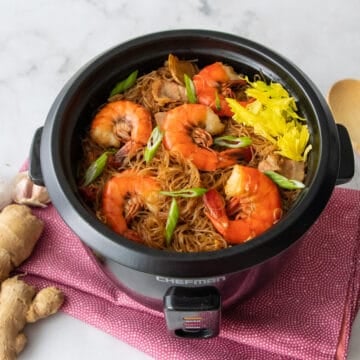
Rice Cooker Noodles with Shrimp and Ginger
Use a rice cooker to simplify and take the guesswork out of this classic Thai noodle dish goong ob woonsen. Glass noodles with shrimp and ginger, done in 15 minutes in even the most basic rice cooker. Feel free to change up the seasonings and create another rice cooker noodle dish of your own!
Ingredients
- 2 tablespoon soy sauce
- 2 tablespoon oyster sauce
- 1 teaspoon black soy sauce or dark soy sauce
- 2 teaspoon sugar
- 1 teaspoon toasted sesame oil
- 1 teaspoon shrimp paste in oil, optional
- 120 mL chicken stock or water
- 80 g dry glass noodles, sometimes labelled "bean vermicelli" or "bean threads"
- 12 oz large size shrimp, deveined with shell on preferred (see note 1)
- 2 slices low-sodium bacon or pork belly, cut into 1-inch chunks, OR use 2 tablespoon neutral oil
- ½ teaspoon ground white pepper
- ½ teaspoon Sichuan peppercorns, crushed (optional)
- 6 cloves garlic, chopped
- 15 slices ginger
- 8 cilantro stems, finely chopped
- 1 handful celery leaves or Chinese celery, chopped
- Jasmine rice for serving, see note 2
Notes
- I like to keep the shells on the shrimp for this method as they help protect the shrimp from overcooking too quickly. I buy the "easy peel" shrimp that come with an open-back, but I recommend using scissors to cut the shell open further, all the way to the tail, to make eating them easier.
- This dish is typically served with rice in Thailand, so the flavour of the noodles are quite strong. You can also eat the noodles on their own, but you may want to cut down on the seasoning slightly then so that it will not be too salty.
Instructions
- Soak glass noodles in room temperature water for 10 minutes to soften. Drain and cut the noodles with scissors in half or thirds to shorten them; this will make them easier to eat.80 g dry glass noodles
- Mix all sauce ingredients together into a large mixing bowl, and stir until the sugar is dissolved. Put the noodles and the shrimp into the bowl and toss to mix. Let this sit until you’re ready to cook.2 tablespoon soy sauce, 2 tablespoon oyster sauce, 1 teaspoon black soy sauce or dark soy sauce, 2 teaspoon sugar, 1 teaspoon toasted sesame oil, 1 teaspoon shrimp paste in oil, 120 mL chicken stock or water, 12 oz large size shrimp
- In a rice cooker, add the bacon or oil, garlic, ginger, chopped cilantro stems, and white pepper and/or sichuan peppercorns. Turn it to “cook” and cook for about 3 minutes or until the bacon fat has rendered and the garlic has softened, stirring once or twice in between. *If your rice cooker will not stay on “cook” mode without the lid on at this stage, it is okay to keep the lid on and open it once or twice to stir in between. You’ll just need to press the cook button again after you put the lid back on. (more on this above)2 slices low-sodium bacon or pork belly, ½ teaspoon ground white pepper, ½ teaspoon Sichuan peppercorns, 6 cloves garlic, 15 slices ginger, 8 cilantro stems
- Use tongs to place the noodles on top of the bacon and herbs, then pour the sauce and the shrimp on top and arrange the shrimp so they’re in one layer. Cover and let the rice cooker cook for about 4 minutes.
- After 4 mins, open the rice cooker and use chopsticks or tongs to stir the noodles, bringing the bottom up the the top, to help redistribute the sauce. Then do your best and bring the shrimp back up to the top, flipping them so the side that is less cooked is facing down (it's not a big deal if a few of them end up under the noodles at this point.) Cover and let it cook again until the rice cooker clicks off, total cooking time should be about 10 minutes but this will vary from machine to machine. *If you have a smart rice cooker, like the Zojirushi Neuro Fuzzy, it should be done as soon as the rice cooker starts giving you a timer countdown, or you can open and check it after noodles have been in there for 10 mins (see more about this above).
- Once the rice cooker clicks off (or switches to warm mode) open and toss everything to distribute all the bits. Taste the noodles, and if they taste a bit underdone, add a splash more water (~2 Tbsp/30 mL) and keep it cooking for a few more minutes. If the shrimp are already cooked at that point, you can remove them before further cooking the noodles.
- To finish, top with celery leaves and/or cilantro and/or green onions, then transfer everything into a serving dish, or serve it right from the rice cooker! Serve with jasmine rice, if desired. PS. The slices of ginger are meant for infusion only and are not meant to be eaten, though you can if you like that strong ginger flavour.1 handful celery leaves or Chinese celery, Jasmine rice for serving
Tried this recipe? Share a pic!Tag @hotthaikitchen on Instagram and Twitter!